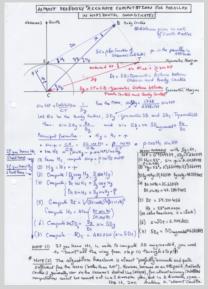
NavList:
A Community Devoted to the Preservation and Practice of Celestial Navigation and Other Methods of Traditional Wayfinding
From: Antoine Couëtte
Date: 2011 Feb 17, 01:21 -0800
Corrected Version (slightly different annex + some changes in text here-below. Apologies for the trouble)
Hello to all,
With 2 Good NavList Friends, we recently stumbled upon a somewhat "imprecise" definition from Jean Meeus in his very well known "ASTRONOMICAL ALGORITMS" book. Certainly it is not a "false" presentation, but certainly too this one does not quite belong either to the class of his most celebrated "crystal clear" definitions.
It all deals with the way to accurately compute the Moon Parallax in a 2 dimension plan. When one needs to accurately compute Topocentric Height from Geocentric height, generally such computation is performed through iterations, since from Topocentric into Geocentric it is quite "straight and forward".
While I first presented them with one such "direct" 2 dimension method, namely with Rectangular-Polar/Polar-Rectangular coordinates transformation, one of these Friends also pointed out that it is possible to use our more familiar Tangent/Arctangent functions to fulfill this aim.
You will find in the enclosed "2 Dimension Parallax Computation.pdf" Annex a detailed algorithm to perform such computation with our usual Tangent/Arctangent functions. For Geocentric Heights and also for the cases when a Body CENTER Topocentric Height is already known, this method no longer requires iterations.
A few complements about the Document in Annex :
1 - As just indicated, if you already know Body CENTER Topocentric Height, in order to compute very accurately Topocentric SD (i.e. Augmented SD) I would recommend to go from Step(1) to Step(7), i.e. "travel" through the Geocentric Height to get back to Topocentric Height and (this time at last) get Observer's Distance from Body Center, which - then and only then - enables to accurately compute Augmented Semi-Diameter. I am aware of "approximate" Augmented SD Formulae derived directly from Topocentric Upper/Center/Lower Heights but the method here-above will give you the utmost accuracy for Augmented SD's. And,
2 - MOON CASE ONLY FOR OUR USUAL CELESTIAL NAVIGATION.
If you observe Body Lower or upper Limb (instead of Body Center) - which is our general case as Navigators - and if you require the Best Accurate Augmented SD, then you cannot (unfortunately) escape at least one iteration. Once Dip + Refraction are taken care of, then from Upper/Lower Limb Height remove/add Geocentric SD (which is immediately available) and from this 1st approximate Topocentric Height enter Step(1) in the Annexed Document. Step(7) yields an updated Augmented SD value. From Upper/Lower Limb Height remove/add such updated Augmented SD value and return to Step(1). At the end of the second pass, Step(7) will yield an updated Augmented SD accurate to much better than 1 arcsecond. And
3 - If utmost accuracy is required, e.g. for satellites work such as GPS, and given that the Earth Center is most generally not on the downwards extension of the Observer's Zenith (i.e. not on the Observer's "Nadir"), then it is necessary to compute in 3 dimension space, which remains my favorite method.
As a conclusion, nothing really amazingly new here. Still, the algorithm presented here (i) requires no iteration when you start from Geocentric Heights in order to reconstruct Topocentric Heights (case of Lunars from a known position), (ii) it also requires no iteration if you already know Body CENTER Topocentric Height rather than Upper/Lower Limb Height, and (iii) it requires only one iteration to accurately compute Augmented SD when starting from Upper/Lower Limb in the Moon Case. Nonetheless and as far as I am concerned, until now I have not found any detailed explanations anywhere (including in the outstanding "ASTRONOMIE GENERALE" by André Danjon) on the way to accurately treat Parallax in Horizontal Coordinates.
Again I wish to thank my very nice NavList Friend who had the idea to tackle Parallax in Horizontal Coordinates with this method.
Hope it may help some fellow NavList Members, just in case …
Best Regards to all,
Kermit
Antoine M. "Kermit" Couëtte
----------------------------------------------------------------
NavList message boards and member settings: www.fer3.com/NavList
Members may optionally receive posts by email.
To cancel email delivery, send a message to NoMail[at]fer3.com
----------------------------------------------------------------







